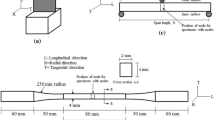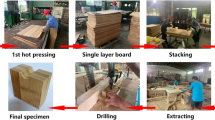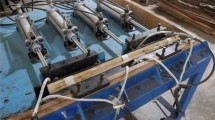Abstract
In this work, the physical and mechanical properties of laminated and densified bamboo elements for use in structural panels were assessed. The physical properties, such as apparent density, water absorption, swelling in radial and tangential directions, the effect of wet–dry cycles on dimensional stability and, surface roughness for un-densified and densified samples before and after wet–dry cycles were studied. Three-point bending tests were also carried out to measure the modulus of elasticity (MOE) and the modulus of rupture (MOR), which was correlated to the fiber distribution profile obtained from image processing of un-densified and densified bamboo samples. In addition, the effect of the bamboo skin (outer layer) on the properties of densified samples was evaluated. The dimensional changes during the wet–dry cycles test started to stabilize after one cycle for un-densified samples and after three to four cycles for the densified samples. The roughness test showed a meaningful variation of surface roughness after one wet–dry cycle for all the samples. The results indicated that densification of bamboo to 34% of densification degree improves both MOR and MOE by up to 81.3% and 36.1%, respectively but sacrifices dimensional stability. Last but not least, it was demonstrated that maintaining the bamboo skin has a positive impact on the all-mentioned analysis and reduces processing steps/costs for the production of high-performance bamboo elements.

















Similar content being viewed by others
References
Archila-Santos HF, Ansell MP, Walker P (2014) Elastic properties of thermo-hydro-mechanically modified bamboo (Guadua angustifolia Kunth) measured in tension. Key Eng Mater 600:111–120. https://doi.org/10.4028/www.scientific.net/KEM.600.111
ASTM, D143-14 (2014) Standard test methods for small clear specimens of timber. American Society for Testing and Materials, West Conshohocken
ASTM, D7264-07 (2007) Standard test method for flexural properties of polymer matrix composite materials. American Society for Testing and Materials, West Conshohocken
Azadeh A, Ghavami K (2018) The influence of heat on shrinkage and water absorption of Dendrocalamus giganteus bamboo as a functionally graded material. Constr Build Mater 186:145–154
Azadeh A, Ghavami K, García JJ (2021a) The influence of heat on mechanical properties of Dendrocalamus giganteus bamboo. J Build Eng 43:102613
Azadeh A, Ghavami K, Savastano Junior H et al (2021b) Static flexural behavior of bamboo as a functionally graded material and the effect of heat on dynamic flexural modulus. J Build Eng 34:101949. https://doi.org/10.1016/j.jobe.2020.101949
Bredenoord J (2017) Sustainable building materials for low-cost housing and the challenges facing their technological developments: examples and lessons regarding bamboo, earth-block technologies, building blocks of recycled materials, and improved concrete panels. J Archit Eng Technol 06:1–10. https://doi.org/10.4172/2168-9717.1000187
BS EN ISO 4287:2000 (2000) Geometrical product specification—surface texture: profile method—terms, definitions and surface texture parameters. British Standards Institution
BS EN ISO 4288:1998 (1998) Geometrical product specification—surface texture: profile method—rules and procedures for the assessment of surface texture. British Standards Institution
Chaowana P, Barbu MC (2017) Bamboo: potential material for biocomposites. In: Jawaid M, Md Tahir P, Saba N (eds) Lignocellulosic fibre and biomass-based composite materials: processing, properties and applications. Woodhead Publishing, UK, pp 259–289
Dixon PG, Semple KE, Kutnar A et al (2016) Comparison of the flexural behavior of natural and thermo-hydro-mechanically densified Moso bamboo. Eur J Wood Prod 74:633–642. https://doi.org/10.1007/s00107-016-1047-9
Gauss C, Kadivar M, Savastano H (2019) Effect of disodium octaborate tetrahydrate on the mechanical properties of Dendrocalamus asper bamboo treated by vacuum/pressure method. J Wood Sci 65:27. https://doi.org/10.1186/s10086-019-1804-6
Gauss C, Harries KA, Kadivar M et al (2020) Quality assessment and mechanical characterization of preservative-treated Moso bamboo (P. edulis). Eur J Wood Prod 78:257–270. https://doi.org/10.1007/s00107-020-01508-x
Ghavami K (2016) Introduction to nonconventional materials and an historic retrospective of the field. Nonconv Vernac Constr Mater Charact Prop Appl. https://doi.org/10.1016/B978-0-08-102704-2.00002-0
Ghavami K, Azadeh A (2015) New approach in image processing for bamboo fiber distribution as functionally graded material (FGM). III Seminário Nacional do Bambu da Rede Brasileira do Bambu-Goiânia. Universidade Estadual de Goiás, Goiânia, pp 22–31
Gibson LJ, Dixon PG (2014) The structure and mechanics of Moso bamboo material. J R Soc Interface 11(2014):0321. https://doi.org/10.1098/rsif
Hidalgo-López O (2003) Bamboo the gift of the gods. D’Vinni Ltda, Bogotá, Colômbia
ISO 22157:2019 (2019) Bamboo structures—determination of physical and mechanical properties of bamboo culms—test methods, Geneva
Kadivar M, Gauss C, Mármol G et al (2019a) The influence of the initial moisture content on densification process of D. asper bamboo: physical-chemical and bending characterization. Constr Build Mater 229:116896. https://doi.org/10.1016/j.conbuildmat.2019.116896
Kadivar M, Gauss C, Savastano H et al (2019b) Physical properties of thermo-hydro- mechanically (Thm) flattened and densified bamboo (Moso and Dendrocalamus asper). XVIII Brazil MRS Meet–Proc, pp 2620–2622
Kadivar M, Gauss C, Ghavami K, Savastano H Jr (2020) Densification of bamboo: state of the art. Materials (Basel) 13:4346. https://doi.org/10.3390/ma13194346
Liese W, Köhl M (2015) Bamboo: the plant and its uses. Springer, New York
Richard MJ (2013) Assessing the performance of bamboo structural components. Doctoral dissertation, University of Pittsburgh
Semple KE, Kamke FA, Kutnar A, Smith GD (2013) Exploratory thermal-hydro-mechanical modification (THM) of Moso bamboo (Phyllostachys pubescens Mazel). In: Medved S, Kutnar A (eds) Characterization of modified wood in relation to wood bonding and coating performance. Proc. COST FP0904 & FP1006 international workshop, October 16–18, Rogla, Slovenia, pp 220–227
Sharma B, Gatoo A, Bock M et al (2015a) Engineered bamboo: state of the art. Proc Inst Civ Eng Constr Mater 168:57–67. https://doi.org/10.1680/coma.14.00020
Sharma B, Gatóo A, Bock M, Ramage M (2015b) Engineered bamboo for structural applications. Constr Build Mater 81:66–73. https://doi.org/10.1016/j.conbuildmat.2015.01.077
Takagi H, Mizobuchi A, Kusano K, Okitsu Y (2008) Flexural properties of all bamboo green composites. WIT Trans Built Environ 97:167–173. https://doi.org/10.2495/HPSM080181
Tanaka K, Inoue M, Fujihara H et al (2006) Development of bamboo connector strengthened by densified technique. In: 9th World Conf Timber Eng 2006, WCTE 2006, vol 2, pp 976–983
Xiao Y, Shan B, Yang RZ et al (2014) Glue laminated bamboo (GluBam) for structural applications. Materials and joints in timber structures. Springer, New York, pp 589–601
Yap Thai Ming C, King Jye W, Ahmad Israr Ahmad H (2017) Mechanical properties of bamboo and bamboo composites: a review. J Adv Res Mater Sci 35:7–26
Yu Y, Wang H, Lu F et al (2014) Bamboo fibers for composite applications: a mechanical and morphological investigation. J Mater Sci 49:2559–2566. https://doi.org/10.1007/s10853-013-7951-z
Acknowledgements
A. Azadeh and M. Kadivar thank the financial support from São Paulo Research Foundation (FAPESP Grant 2018/25011-9 and 2020/00827-6, respectively), H. Savastano Junior is also thankful to Brazilian National Agency CNPq for the financial aid (Grant 307723/2017-8). All the authors gratefully acknowledge the Construction and Ambiance /USP laboratories for the availability of the required infrastructure for doing the experiments. The FZEA/USP staffs are also sincerely acknowledged for their kind assistance in the bamboo harvesting process.
Author information
Authors and Affiliations
Corresponding author
Ethics declarations
Conflict of interest
The authors declare that they have no known competing financial interests or personal relationships that could have appeared to influence the work reported in this paper.
Additional information
Publisher's Note
Springer Nature remains neutral with regard to jurisdictional claims in published maps and institutional affiliations.
Rights and permissions
About this article
Cite this article
Azadeh, A., de Sá, A.D., Kadivar, M. et al. The effect of densification on physical and mechanical properties of bamboo Dendrocalamus asper. Eur. J. Wood Prod. 80, 877–888 (2022). https://doi.org/10.1007/s00107-022-01823-5
Received:
Accepted:
Published:
Issue Date:
DOI: https://doi.org/10.1007/s00107-022-01823-5




